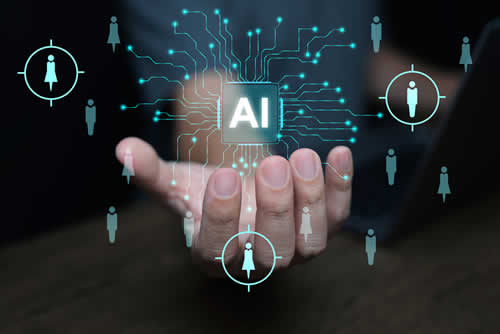It doesn't really need to be said that artificial intelligence (AI) has the potential to transform day-to-day jobs in ways that were unimaginable (by most of us, anyway) just a few years ago. And nowhere is that more so than in recruitment.
Even now, in what are clearly its early stages, AI can be used by companies in all industries to streamline their hiring processes and improve their decision-making. But if you want to integrate AI into your recruitment process, you'll need more than just an app to help with selection. Instead, you'll need to take a wider ranging and carefully structured approach.

In this article, we provide a simple step-by-step guide to building an AI-ready recruitment process that will help with implementation and ensure long-term success. In this way you can
screen candidates with AI with the benefit of a process that avoids the key problems that often arise.
Assessing Your Current Recruitment Process
Before you think about introducing AI into your organization, you need to look at what happens right now. So start
evaluating your recruitment process. Identify any inefficiencies, like long screening times, high costs, or poor experiences in the past. Assess the metrics – things like time-to-hire, quality of hires, and employee retention rates – so you can identify areas for improvement. And if you're armed with these problem areas, you'll already be set up to find a targeted solution.
Get your HR and IT team to carry out this assessment together. HR professionals will bring their experience of the process of hiring, whereas IT experts will evaluate the technological requirements needed. This combined effort will help ensure that when AI is introduced, it'll be where it's most needed and has the greatest potential impact.
Setting Clear Objectives for AI Integration
Once you've identified any gaps you have in the process (and for your own benefit, assume you have them!) you need to define clear objectives. For example, look at areas like reducing time-to-hire, improving the candidate experience, or maybe increasing the diversity of applicants. By setting specific goals, you'll be sure that the solution you choose is consistent with broader business objectives.
Choosing the Right AI Tools
The market is absolutely flooded with
AI recruitment tools! They range from resume-screening software to AI-powered chatbots and predictive analytics platforms. And you're right to think you have a baffling range of options in front of you. So you need to carefully evaluate what's on offer. Focus on the kind of features that address your precise needs.
For instance, you may want to automate repetitive tasks: if so, you should be looking for tools with advanced resume parsing and filtering abilities. If you don't do this, the tools you choose won't meet your needs. You won't get what you want, and you'll probably waste time and money on elements that are irrelevant.

You want to get the most for your money, don't you? So appraise all potential tools based on their cost, their ease of integration with existing systems, and the quality of vendor support. The vendor should tell you, openly, how their software works and how it uses AI to tackle issues like bias. So make absolutely sure you get honest answers to your questions. Any evasiveness or muddying on their part and you should walk away. Reject any attempt to baffle you with jargon. After all, the pressure should be on them to prove their worth, not on you to make sense of what they say.
Preparing Your Data for AI
AI systems rely on high-quality data if they're going to work properly. So as an early step, review your existing recruitment data. Make sure it's accurate, structured, and relevant. You should also arrange to clean and organize data to eliminate any irregularities, duplicate entries, or incomplete records.
For example, you may want to include data from different sources to ensure fairness in candidate evaluations. These sources may well provide data that needs cleaning up. And only then will AI be able to make sense of it to reduce bias in decision making.
Training Your Team on AI
But adopting AI in recruitment isn't just about technology! It's also about getting your team to use these tools effectively. Accept that people will need to upskill over time in order to interpret the insights that AI provides, and use them in their decision-making. There are different ways to do this. Obviously, online courses usually provide the lowest cost and the most flexibility. But also look at in-person workshops or vendor-led tutorials to enhance their training.

Also encourage HR and IT teams to work together so there's a smooth transition, too. As you increase people's confidence in using AI tools, you'll build acceptance and you'll maximize the benefits of the technology.
Prepare to Upgrade!
If you wait for the perfect solution, you'll wait for ever. Especially in any tech environment where advances are being made all the time.
But this doesn't mean you should just jump in and assume you'll deal with any problems with out of date software when they arise. If your software has no ability to upgrade, you could be faced with starting the process all over again a a couple of years' time. Or watching everyone endure the frustration of chundering on with a system that's obsolete.
So research what developments are likely in the near future. And ask what provisions vendors have for upgrading their software - and how much it would cost. Play dumb a little: don't mention your research and see what they say. They could surprise you with new ideas ... or their lack of plans.
You won't end up with the perfect solution, but you'll extend the life of your system by some distance.
The Benefits of AI Tools in Recruitment
Building an AI-ready recruitment process is a big job that always requires careful planning and execution. As we've said, you'll need to assess the processes you already have in place, set clear objectives, choose the right tools, prepare the data and train your team. All these jobs need steady and considered application. And by implementing AI on an incremental basis, you'll be able to maximize the benefits of what will prove to be game-changing technology.
But also remember to start small and measure your success and scale over time so there's a smooth integration into your recruitment activity.
If you follow our guidelines, you'll avoid costly mistakes and be sure to maximize the benefits of a sleeker, fairer and more effective recruitment process.



























